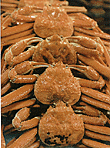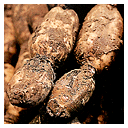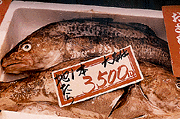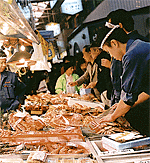One of the places
that tourists to Kanazawa usually visit is Omicho
Market. It is very popular and is always mentioned in guidebooks.
I also went to Omicho Market some time ago and found
a throng of people there, who were easily identifiable as tourists.
It was the height of the snow crab season, so everywhere you
looked there were fish shops, overflowing with crabs, as if the
place was screaming, "Crabs! Crabs! Crabs!" For a while
I was in awe of the sheer number of people gathered in one place.
It's fun to walk around, looking at a market. There is so much
activity, and looking at it brimming with fish, vegetables and
fruit, one gets the impression that the market itself is a living
organism, although this is probably an exaggeration.

Perhaps it is because I am a chef that I like looking at markets
so much. I often look at markets when I am travelling on business,
as one can get an idea of what the local diet is like from the
local market. As for Omicho Market, it gives me
the impression that the local diet must be very good.
The first reason I get this impression is that there is such
a wide variety of ingredients offered. Seasonal seafood and vegetables
lie crammed into the market stalls. This means that there must
be a local demand for all these ingredients, which indicates
that the local diet must be very good. The second reason is the
freshness of the ingredients. Both fish and vegetables are extremely
fresh. The yellowtail and cod are so fresh that you wonder if
they are still alive. The lotus root even has soil still stuck
to it, and the turnips, daikon radishes and so on all
look delectable. Since the range and freshness of the ingredients
are so good, it follows that the local cuisine is also bound
to be good. I think Kanazawa is very fortunate when it
comes to food.

By the way, this is a slight digression,
but let's take a look at the origins of the market.
In the third century, it was customary for people to gather
in a particular place to worship the gods. People would use these
occasions as an opportunity to bring along produce they had grown
themselves and trade it for other goods. For example, in ancient
Yamato there was a particular place where some giant camellia
trees (tsubaki) were the focus of god worship. A market was established
at this site and named Tsubaki Market.
People lived a mainly self-sufficient lifestyle then, with
the bartering system providing them with the goods that they
could not produce themselves. For example, one could trade fish
for rice or rice for salt. In those days, shopping was not a
matter of choosing among various goods for oneself. Rather, individuals
would create a market by gathering together, each bringing along
his or her own goods. Gradually, people began trading more as
"buyers" or "sellers", the variety of goods
increased and markets became more lively and prosperous. These
days, the remains of this can be seen in the Wajima morning
and evening markets and the Takayama morning market. The
barter of goods, such as rice in agricultural villages and salted
dried fish in coastal towns, has actually gone on between individuals
right up until recent years.
At a market place, people worshipped the god of the market,
and for this people gathered together and traded goods. Thus
the modern day market was derived. Omicho Market
also developed in this way.
 Omicho
Market may have been named after the town of Omi.
Right next to the market is the Ichihime Shrine. This
shrine was originally the Ichihime Shrine on Gojo
Street in Kyoto. It appears that the people who moved
it to Kanazawa were merchants from Omi, which may
have been the reason that the market was named Omicho.
However, we are not certain of the true origins of its name.
This is just one of many possible explanations.
Omicho
Market may have been named after the town of Omi.
Right next to the market is the Ichihime Shrine. This
shrine was originally the Ichihime Shrine on Gojo
Street in Kyoto. It appears that the people who moved
it to Kanazawa were merchants from Omi, which may
have been the reason that the market was named Omicho.
However, we are not certain of the true origins of its name.
This is just one of many possible explanations.
I have gone on a lot about Omicho
Market. But just on one last point, I would like to tell
you what I heard in a taxi, while travelling from Kanazawa
station to the market. The taxi driver said to me, "Mister,
make sure you bargain with them when you shop at the market."
Apparently, because there are so many tourists, the vendors put
high prices on their goods. "Even this market, Kanazawa's
kitchen, has become wise to the world," I was told, and
I felt a pang of longing for the old days. I suppose that, among
the local young people, large supermarkets have become more popular.


